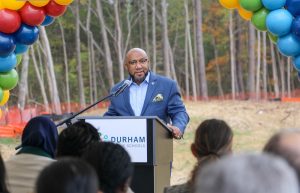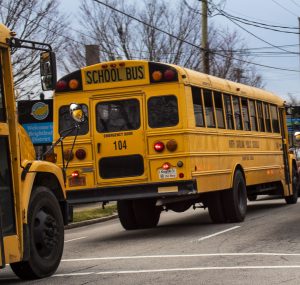Shutting down
On March 13, 2020, only one hour and 45 minutes remained in the school day when Lindsay Johnson, a fourth-grade teacher at Forest View Elementary, learned that all Durham Public Schools were shutting down.
Teachers immediately wondered what this would mean for their students, and for DPS families. They sent parent volunteers running to their copy machines, to prepare as much school material as possible to send home with students. They frantically bagged up the healthy snacks donated each week by a local nonprofit, so the food would not go to waste when students left the school.
When school buses arrived to take the students home, no one knew how long they would be staying there.
“We had to make sure — if this is our last moment with our kids, for whatever length of time — they have everything that we can give them,” Johnson recalled. “We all hugged our kids and saw them off to the buses, not knowing what this was going to mean for the months ahead.”
Johnson, 28 years old, has been a teacher for seven years. As her students drove away that afternoon, she figured that DPS would just have to reschedule spring break. This pandemic would blow over, and the school community would be back together in about a week.
One year later, students had yet to return to Forest View Elementary.
Transitioning to the new normal
While DPS staff developed plans to continue learning during the unfolding COVID-19 pandemic, Johnson kept in touch with her 21 students and their parents via telephone. She checked in to make sure they were OK and gathered information on what resources each family needed for remote instruction. Educational materials were distributed by mail and at scheduled pick-up locations.
Students had learning packets to complete each week. Not every student had access to a device that would allow for classroom Zoom sessions, so teachers stayed in touch with them individually.
But some students couldn’t Zoom or video chat; for a geometry lesson, Johnson texted pictures of drawings to them.
Johnson often taught each lesson three different times, depending on the group of students and their means of learning.
Most of her students had family computers or parents’ smartphones, so she scheduled Zoom lessons with them. For other students, Johnson taught the same lesson using the mobile app Duo to video chat. But some students couldn’t Zoom or video chat; for a geometry lesson, Johnson texted pictures of drawings to them.

Teachers offered whatever emotional or academic support they could. Johnson met with her students about their packets three times a week for an hour and a half.
“Some of us were leading morning meeting sessions, and really focusing on social and emotional learning. Some of us tried to create a semblance of normalcy for students and went more of the academic route,” Johnson said.
“[The protocol] was: however you can get connected with your students, whatever you need to do to provide whatever it is they need — academics or social and emotional — do what you can. It varied from building to building and class to class of what that looked like.”
Even with the new difficulties this pandemic year would bring, Lindsay Johnson kept her focus on making each child feel confident and successful.
She had known she wanted to be a teacher since she was a student herself, growing up in Fayetteville. Her seventh-grade teacher pushed her out of her comfort zone by encouraging her to answer questions in class.
“You have the ability to achieve whatever it is you want, and I’m going to help you build those skill sets to do what you want to do in your life.”
“I thought to myself, ‘I’m not smart, I’m not that kid,’” Johnson recalled. “But she continued to show me that I was capable and I was smart. It doesn’t feel good to feel that you’re not smart.
“I want to be the person that shows every student I come across, that you are capable and you are smart. You have the ability to achieve whatever it is you want, and I’m going to help you build those skill sets to do what you want to do in your life.”
With her fourth-graders, Johnson held social hang-out days, math lessons, reading lessons and science demonstrations. She hosted a book club for students who wanted more interaction with each other.
Her nine- and ten-year-olds were accustomed to using technology for games and entertainment, not for school. The transition to remote learning was difficult at first because Johnson had to teach her students how to use technology in a way to help them learn. She taught them the basics of finding links, understanding a URL bar, and how to refresh a web page.
In August, the start of the 2020-2021 school year paired Johnson with a new group of fourth-graders — children she’d never had the chance to meet in-person before the pandemic hit. It posed an even greater challenge for building relationships.
“Connecting with my students was one of my biggest worries,” Johnson said. “Being a fourth grade teacher, I normally see the kids come down the hall, and I normally see faces.”
Each teacher at Forest View Elementary holds a 30-minute meeting with their class at the start of each day, and this has helped Johnson connect with her students. The meetings are focused on community-building, with teachers sharing meaningful quotations and asking students about how they are feeling. Sometimes a school counselor will join the session.
“Sometimes the topic of the day hits really close to home, and students need more time to process and think about how they’re feeling,” Johnson said. “We take that moment to address where students are and how they’re feeling — because if they’re not processing those emotions, then starting the day would be a disservice to them. If we were to just start straight into academics, I think we would’ve seen a lot of kids disengaged.”

The constraints of remote instruction have made it difficult to cover as much academic material as in the past, she said. Teaching computer skills and focusing on emotional support takes time away from the standard subjects of reading, writing, math, science and social studies.
“If the students aren’t emotionally prepared or feeling supported, they’re not going to be in a head space to learn academically,” Johnson said. “There are so many other factors that we had to account for in this virtual setting that decrease the amount that we can actually cover in a school year, if we were to remain virtual versus being in the classroom.”
“I would rather ensure every child has a foundation in math than to throw everything I got at them, math-skill-wise, and see what happens.”
Rather than rush to teach her students each individual skill in fourth-grade math, she slowed down to focus more on the fundamentals.
“Math is so intricate, with so many skills and foundational pieces. So if you don’t have the foundational understanding and you continue to build on it, that house is gonna crumble,” Johnson said. “I would rather ensure every child has a foundation in math than to throw everything I got at them, math-skill-wise, and see what happens.”
Returning to in-person learning
When the DPS school board decided on March 2 to begin returning to in-person instruction, educators worried about the risk of increased exposure to the coronavirus. Johnson’s phone was flooded with text messages from fellow teachers, sharing resources on places they could get vaccinated.
Forest View Elementary resumed in-person instruction on March 15. Two days later, Johnson received her second dose of the vaccine.
“It felt like a weight was lifted off my shoulders,” she said. “Not that I let my guard down, because safety is still the number-one concern. It sounds weird, but it was like I wasn’t scared of death or the prospect of getting terribly ill any more.”
According to the DPS COVID Dashboard, Forest View Elementary has had zero positive COVID-19 cases since reopening, however DPS elementary schools as a whole have had 27 cases among students and 15 cases among staff since March 2021.
“It’s been really good to see students in the building,” Johnson said. “You can tell that they’re enjoying themselves. But … students are slowly but surely realizing that just because we’re in the building doesn’t mean things are gonna be like how they were prior to COVID.”
Although students and teachers are together again at school, they wear their masks and maintain social distance in the classroom and on the playground. Collaborative work, which normally would entail a table group with shared supplies that students would use to create something together, is often virtual.
The challenges of virtual learning are not over. Johnson is teaching a hybrid fourth-grade class now, with 10 students in person and 12 online.
“I’m still accounting time for making sure the students online feel connected and part of the classroom, and making sure I’m dividing my attention among both groups equitably,” Johnson said. “It’s a delicate dance. It’s definitely a dance that can be exhausting at the end of the day.”
“We’re still all in this together, even though there are some students who are physically in the buildings and some students who are at home.”
Johnson continues to use virtual platforms in her physical classroom. The students with her in the classroom have their laptops and tablets, and they often connect online to collaborate with students who are learning from home.

“So we’re still all in this together, even though there are some students who are physically in the buildings and some students who are at home,” Johnson said.
The challenges that the pandemic has posed on the education system are strong, but Johnson says she is still working based upon her belief that every child has a right to a quality education.
“Fourth graders are like sponges soaking everything up,” Johnson said. “It gives me a sense of hope for what our future can be.”
9th Street Journal reporter Kathleen Hobson can be reached at kathleen.hobson@duke.edu
At top: Fourth grade teacher Lindsay Johnson with her students at Forest View Elementary School. Photo by Sho Hatakeyama




